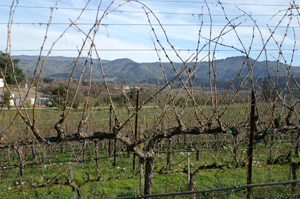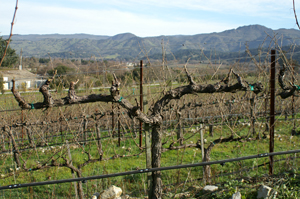PRUNING: The Single Most Important Activity in Vineyard Management
During the winter or early spring when the vines lay dormant is the time to prune. Pruning is, quite simply, the cutting back of excess dormant and dead wood, and is the most important step in vineyard management. Prior to coming into its winter dormancy, each vine sets its buds for the upcoming year. The buds fruitfulness is governed by the growing patterns of the past season and it is up to the viticulturalist to prune accordingly so that the vine is not stressed and produces a healthy harvest. Pruning must be undertaken with care as it is the single most important act that directly affects the balance of the vine.
 |
 |
| Before | After |
Pruning saves a cultivated vine from self-destruction. Left alone, it would simply grow until it becomes unproductive. The seemingly aggressive act of pruning allows the vine to maintain a healthy vigor and achieve its best crop potential. Also, the vine has to be maintained in a workable shape that will facilitate vineyard management practices such as spraying and harvesting. Pruning achieves a balance between vegetative and fruit growth which basically means there should be enough leaves to ripen the fruit produced in a canopy that provides an optimum microclimate; i.e. not too much shade, not too much sunshine.
It’s important not to let the vine get too big, as a large vine spends too much of its energy growing canes and leaves, rather than concentrating flavors in the grapes. If we leave too many buds, we get too many shoots which tend to have more, but smaller, clusters of grapes. Conversely, if we don’t leave enough buds, we would get fewer shoots with larger clusters and a lower yield. At Morningside Vineyard, we prune to achieve a low yield per vine which enables the vine to produce fruit of exceptional quality, which translates into excellent wine.
In the life cycle of a vineyard, vines reach their prime in their sixth to tenth year. That is when the vines reach their prime balance. Pruning consistently follows the patterns established in early years. At year fifteen, a vine has reached full maturity, growth is regular and the plant is mellowed and balanced. At this point we have smaller yields but higher quality grapes which are needed to produce a superb wine. Morningside Vineyard is now at that point.
A few terms describing a grapevine might be helpful. The main support for all vines is the trunk. Growing laterally from the trunk are arms or cordons. On each cordon we normally leave 5 spurs, or 10 spurs to a vine. Typically we leave 2 buds per spur and the new shoots grow from these buds. From the new shoot growth we get the new grape clusters. We then leave 2 clusters per shoot. The goal of pruning is to ‘balance’ the vine so that fruit production and vine growth are ‘balanced’, providing enough green leafy growth to support the fruit crop and to allow the correct mixture of sun and shade to insure optimally ripened grapes.
We are often asked how many bottles of wine can be produced from our vineyard, so here are some benchmarks based on our farming practices. A single vine pruned and tended to produce a high-end wine will yield enough grapes to make approximately one and a half bottles of wine. And, it takes about 4 grape clusters to produce a glass of wine. Our yields, due to the pruning and aided by the rocky terrain, are approximately 2.5 tons per acre compared to a more normal yield in the 4 ton or greater range. Each ton of grapes makes approximately 2 barrels of wine and each barrel produces about 25 cases of wine. Pruning is the primary method of controlling these yields and managing our grape quality.
